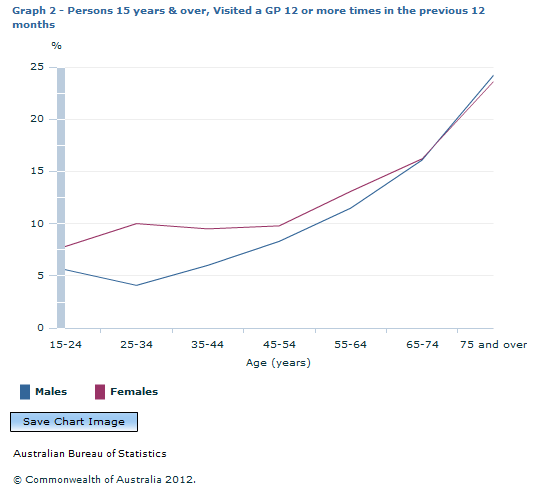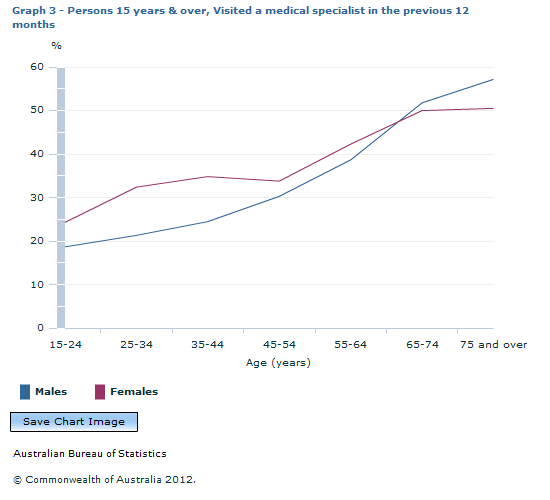4839.0 - Patient Experiences in Australia: Summary of Findings, 2011-12  Quality Declaration
Quality Declaration
ARCHIVED ISSUE Released at 11:30 AM (CANBERRA TIME) 05/12/2012
Page tools:
 Print Page Print Page
 Print All Print All
| ||
|
This chapter presents data on people who had seen a general practitioner (GP), medical specialist or dental professional in the previous 12 months. Respondents were asked about the frequency of their visits, as well as about the services they had used, waiting times and financial barriers to accessing care. Aspects of communication with GPs, specialists and dental professionals are discussed in Experiences with Health Professionals. Most people aged 15 years and over accessed health services during the past year. Graph 1 shows that GPs were the most common health service accessed in 2011–12 (81%), with dental professionals being the second most common (49%), followed by medical specialists (33%). (Table 1)  Footnote(s): (a) Includes dentist, dental hygienist or dental specialist Source(s): Patient Experiences in Australia: Summary of Findings VISITS TO GPs Around 14.6 million people aged 15 years and over (81%) visited a GP at least once in the previous 12 months. This is very similar to 2009 (81%) and 2010–11 (82%). A higher proportion of females than males visited a GP (86% and 76% respectively). (Tables 1 and 2) Frequency of visits The number of times a person visited a GP in the previous 12 months was related to how healthy they considered themselves to be. Of those who had seen a GP, around 77% of people who considered their health to be only fair or poor had visited a GP four or more times in the previous 12 months, compared with 37% of those who felt their health to be good, very good or excellent. (Table 9) The frequency of seeing a GP was also related to whether the respondent had a long term health condition. Of those who saw a GP, those with a long term health condition were more likely to have gone 4–11 times in the previous year (42%) compared with those without a long term health condition (23%). Those with a long term health condition were also more likely than those without a long term health condition to have gone twelve or more times (18% compared with 3%). (Table 9) In addition, the frequency of seeing a GP varied with age. Around 70% of people aged 75 years and over who had seen a GP had seen one on four or more occasions in the previous year, almost twice the proportion of people aged 45–54 (38%) and of those aged 15–24 (37%). Almost one quarter (24%) of people aged 75 years and over who had a seen a GP had done so 12 or more times in the previous year, compared with 9% of people aged 45–54 years and 7% aged 15–24 years. (Table 10) Graph 2 shows that females in the age groups most closely related to child bearing (15–44 years) are much more likely than males the same age to have visited a GP 12 or more times in the previous year.  Waiting times Of those who needed to see a GP in the previous 12 months, 27% had waited longer than they felt was acceptable to get an appointment with a GP. (Table 6) Of those who needed to see a GP for urgent medical care in the previous year, 14% reported that their health had deteriorated either a little or a lot between when they made an appointment and when they saw a GP. On the other hand, 5% felt that their health had improved in this time. (Table 11) Barriers Around 7% of people who needed to see a GP in the previous 12 months had delayed seeing or had not seen one because of the cost. (Table 7) VISITS TO MEDICAL SPECIALISTS Around 6 million people aged 15 years and over (33%) had visited a medical specialist in the previous 12 months. A higher proportion of females than males visited a medical specialist (36% and 31% respectively). (Table 2) Frequency of visits The number of times people had visited a medical specialist in the previous 12 months was related to how healthy they considered themselves to be. Around 43% of people who considered their health to be only fair or poor had visited a medical specialist four or more times in the previous 12 months, compared with 22% of those who felt their health to be good, very good or excellent. (Table 14) The frequency of seeing a medical specialist was also related to whether the respondent had a long term health condition. Overall, out of the population who saw a medical specialist, those with a long term health condition were significantly more likely to have gone four or more times in the previous year (32%) compared with those without a long term health condition (17%). (Table 14) Older people were generally more likely than younger ones to have visited a medical specialist. Females in age groups where maternity services are common (15–44 years) were more likely than males to have seen a medical specialist in the past year. The proportion who had seen a medical specialist in the previous 12 months increased from 19% of males aged 15–24 to 57% of males aged 75 years and older, and from 24% of females aged 15–24 to 50% of females aged 75 years and older. (Table 2)  Barriers Around 8% of people (just under 600,000) who needed to see a medical specialist in the previous 12 months delayed or did not see one because of the cost. Females were more likely to delay seeing or not see a medical specialist due to cost (10% of females compared with 7% of males). (Table 7) VISITS TO DENTAL PROFESSIONALS Nationally, nearly half of people aged 15 years and over had seen a dental professional at least once in the previous 12 months (49%). As with GPs and medical specialists, more females than males had seen a dental professional (52% compared with 45%). (Table 2) As shown in Graph 4, whether people had seen a dental professional varied by age and sex. For males, 38% of those aged 25–34 saw a dental professional in the previous 12 months compared with 52% of those aged 65–74. For females, 41% of those aged 75 years and over saw a dental professional compared with 61% of those aged 55–64. (Table 2) .gif) Footnote(s): (a) Includes dentist, dental hygienist or dental specialist Source(s): Patient Experiences in Australia: Summary of Findings Of those who had seen a dental professional in the previous 12 months, 90% had visited a private dental clinic on the most recent occasion, while 9% had visited a government dental clinic. However, these rates varied across socio-economic areas, with 19% of people living in areas of greatest disadvantage accessing a dental professional at a government dental clinic, compared with 3% of people living in areas of least disadvantage. (Table 12) Waiting times Of those who had seen a dental professional for urgent care in the previous 12 months, 20% were seen within four hours, while 43% waited two or more days between making the appointment and seeing the dental professional. (Table 11) Barriers Just over one in five people who needed to see a dental professional had delayed seeing or had not seen one in the previous 12 months because of the cost (21%). People aged 25 to 34 were the most likely to delay seeing or not see a dental professional because of cost with 31%, compared with 5% for those aged 75 years and over. Around 27% of people living in areas of greatest disadvantage had delayed going or not gone to a dental professional due to cost in the previous 12 months, compared with 15% of people in the areas of least disadvantage. (Tables 5 and 7) Document Selection These documents will be presented in a new window.
|
|
